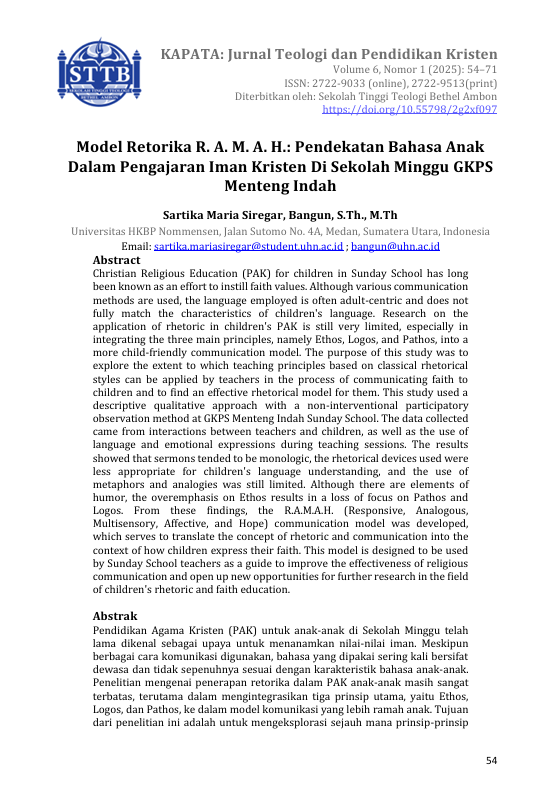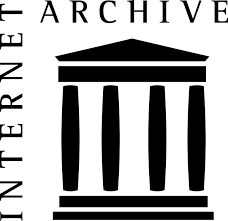MODEL RETORIKA R. A. M. A. H.
PENDEKATAN BAHASA ANAK DALAM PENGAJARAN IMAN KRISTEN DI SEKOLAH MINGGU GKPS MENTENG INDAH
DOI:
https://doi.org/10.55798/2g2xf097Abstract
Christian Religious Education (PAK) for children in Sunday School has long been known as an effort to instill faith values. Although various communication methods are used, the language employed is often adult-centric and does not fully match the characteristics of children's language. Research on the application of rhetoric in children's PAK is still very limited, especially in integrating the three main principles, namely Ethos, Logos, and Pathos, into a more child-friendly communication model. The purpose of this study was to explore the extent to which teaching principles based on classical rhetorical styles can be applied by teachers in the process of communicating faith to children and to find an effective rhetorical model for them. This study used a descriptive qualitative approach with a non-interventional participatory observation method at GKPS Menteng Indah Sunday School. The data collected came from interactions between teachers and children, as well as the use of language and emotional expressions during teaching sessions. The results showed that sermons tended to be monologic, the rhetorical devices used were less appropriate for children's language understanding, and the use of metaphors and analogies was still limited. Although there are elements of humor, the overemphasis on Ethos results in a loss of focus on Pathos and Logos. From these findings, the R.A.M.A.H. (Responsive, Analogous, Multisensory, Affective, and Hope) communication model was developed, which serves to translate the concept of rhetoric and communication into the context of how children express their faith. This model is designed to be used by Sunday School teachers as a guide to improve the effectiveness of religious communication and open up new opportunities for further research in the field of children's rhetoric and faith education.
Downloads
References
Albet Saragih. (2017). No Title.
Ansanay, W. F. (2021). Komunikasi Guru Pendidikan Agama Kristen dalam Memacu Minat Belajar Siswa. Apokalupsis, 2(1), 49–66.
Bangun, B., Ida Ike Siregar, S., & Rajagukguk, W. (n.d.). Human Development Index and Junior Secondary National Exam Scores in Indonesia. In International Journal of Environmental Sciences (Vol. 11). https://www.theaspd.com/ijes.php
Bangun, J., & Suhadi, S. (2023). Makna Logos dan Logika dalam Yohanes 1:14 bagi Pertumbuhan Iman Kristen Masa Kini. Jurnal Teologi Berita Hidup, 5(2), 546–567. https://doi.org/10.38189/jtbh.v5i2.387
Bowo, N. H. (2003). Analisis Pengaruh Kepercayaan. In Sains Pemasaran Indonesia: Vol. II (pp. 85–92).
Chakor Ventures. (2025). No Title.
Cyrek, O., Heraklita, O., & Ewangelisty, J. (2023). Starożytne koncepcje Logosu . Grecki termin logos etymologiczne pochodzi od czasownika lego , gdzie rdzeń. 55, 5–47.
Dahliana, D. (2005). Sejarah dan perkembangan retorika. Humaniora, 17(2), 142–153.
Dohn, N. B. (2002). Roles of the Body in Learning. 1–28.
Emanuel, B., Rodrigues, C., & Martins, M. (2015). Rhetoric of interaction: Analysis of pathos. Lecture Notes in Computer Science (Including Subseries Lecture Notes in Artificial Intelligence and Lecture Notes in Bioinformatics), 9186(August 2015), 417–427. https://doi.org/10.1007/978-3-319-20886-2_39
Emiyati, A. (2025). Pendidikan Agama Kristen Anak dan Remaja: Panduan untuk Guru.
Etika, P., Dalam, K., & Agama, P. (2021). KARAKTER Yuli Ferianti * 1 PENDAHULUAN Pendidikan adalah dasar utama bagi semua manusia , salah satunya “ etika .” Pendidikan tidak lain adalah upaya itu ? Pendidikan Agama mulai ketika Agama sendiri mulai muncul dalam hidup manusia . 2 Yesus adalah conto. 1(2), 1–14.
Gultom, M. (2024). REAL DIDACHE : Journal of Christian Education. REAL DIDACHE: Journal of Christian Education, 4(1), 17–30.
Haase, F. (2014). Rhetoric and the concept of the origin (Motyw pocz ą tku z perspektywy retorycznej). Res Rhetorica, 1(1), 1–14.
Hamid, Z., Berhan, N., & Wahab, K. A. (2015). Application of rhetorical styles as a determinant of the effectiveness of oral communication in public lectures. Jurnal Komunikasi: Malaysian Journal of Communication, 31(2), 673–686. https://doi.org/10.17576/jkmjc-2015-3102-38
Hyde, B. (2008). Weaving the threads of meaning: A characteristic of children’s spirituality and its implications for religious education. British Journal of Religious Education, 30(3), 235–245. https://doi.org/10.1080/01416200802170169
Hyde, B. (2010). Godly play nourishing children’s spirituality: A case study. In Religious Education (Vol. 105, Issue 5, pp. 504–518). https://doi.org/10.1080/00344087.2010.516215
Immink, G. (2019). HTS Teologiese Studies/Theological Studies. http://www.hts.org.za
Kristen, B. P. (2022). Komunikasi_Pengajaran_Yesus_Menjadi_Role_Model_Bag. 8(4).
Malkisedek, M., & Yusuf, V. (2020). Analysis of teaching aids as an effective Sunday school learning media for Exodus stories. … of the International Conference on Art …, 2019.
Marinda, L. (2020). Teori Perkembangan Kognitif Jean Piaget Dan Problematikanya Pada Anak Usia Sekolah Dasar. An-Nisa’ : Jurnal Kajian Perempuan Dan Keislaman, 13(1), 116–152. https://doi.org/10.35719/annisa.v13i1.26
Martha, I. N. (2010). Retorika Dan Penggunaannya Dalam Berbagai Bidang. Prasi, 6(12), 61–72.
Martin, L. R. (2017). Rhetorical Criticism and the Affective Dimension of the Biblical Text. Journal for Semitics, 23(2), 339–353. https://doi.org/10.25159/1013-8471/3496
Mercier, H. (2011). Reasoning serves argumentation in children. Cognitive Development, 26(3), 177–191. https://doi.org/10.1016/j.cogdev.2010.12.001
Mundosaragi. (2021). No Title. August.
Permana, N. S. (2020). Yesus Sebagai Guru Ditinjau Dari Pendekatan Mengajar Dan Relevansinya Bagi Guru Agama Katolik. JPAK: Jurnal Pendidikan Agama Katolik, 20(2), 83–97. https://doi.org/10.34150/jpak.v20i2.248
Poster, C. (2008). Logos and Rhetoric. The International Encyclopedia of Communication. https://doi.org/10.1002/9781405186407.wbiecl032
Ramos-Silva, S. (2010). “Deus caritas est”: bases para a operacionalização da noção de éthos. Estudos Semióticos, 6(2), 30. https://doi.org/10.11606/issn.1980-4016.esse.2010.49268
Sabda, Y. L. (2020). Guru Sekolah Minggu. Sabda, 1–200.
Saponaro, C., Carioti, D., Riva, M., & Guasti, M. T. (2025). Reaching Meaning through Language: What can Children Tell Us about Distributivity? Journal of Child Language, 1–21. https://doi.org/10.1017/S0305000925000224
Schonert-Reichl, K. A., & Hymel, S. (2007). Educating the heart as well as the mind: Social and Emotional Learning for School and Life Success. Education Canada, 47(2), 20–25.
Senggok, G. F. (2022). Retorika Pendidik dalam Penyampaian Materi Pembelajaran Pada SD Negeri 1 Biak Kota. 6–27.
Spence, A. J. (2007). Incarnation and Inspiration: John Owen and the Coherence of Christology. In Incarnation and Inspiration: John Owen and the Coherence of Christology. Bloomsbury Publishing Plc. https://doi.org/10.1163/156973108x333786
Sulistyarini, D. & Zainal, G. A. (2018). Buku Ajar RETORIKA. In CV. AA. Rizky (Vol. 51, Issue 1).
Tulung, J. M., Wuwung, O. C., Zaluchu, S. E., & Zaluchu, F. R. B. (2024). Deuteronomy and Contextual Teaching and Learning in ChristianTulung, J. M., Wuwung, O. C., Zaluchu, S. E., & Zaluchu, F. R. B. (2024). Deuteronomy and Contextual Teaching and Learning in Christian-Jewish religious education. HTS Teologiese Studies / Theol. HTS Teologiese Studies / Theological Studies, 80(1), 1–9. https://doi.org/10.4102/hts.v80i1.9312
Vidal, R. (2013). El êthos y la formación humanística en Isócrates.
Zatwardnicki, S. (2021). An incarnational analogy that is hard to escape from: A polemic with James Prothro. In Collectanea Theologica (Vol. 91, Issue 2, pp. 37–75). Cardinal Stefan Wyszynski University in Warsaw. https://doi.org/10.21697/CT.2021.91.2.03

Downloads
Published
Issue
Section
License
Copyright (c) 2025 Sartika Maria Siregar, Bangun Bangun (Author)

This work is licensed under a Creative Commons Attribution-NoDerivatives 4.0 International License.









